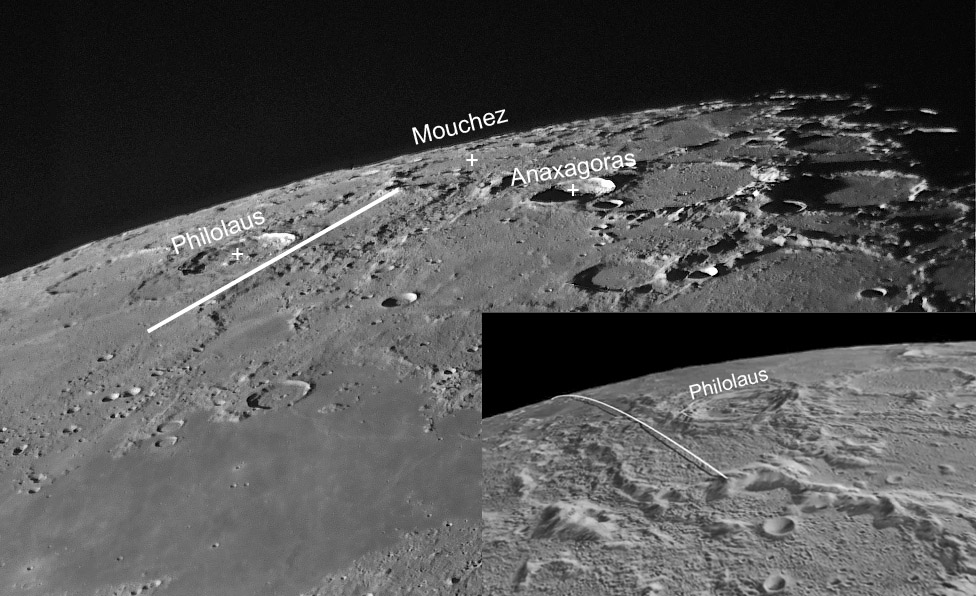Difference between revisions of "December 16, 2012"
| Line 12: | Line 12: | ||
<br /> | <br /> | ||
<strong>Related Links</strong><br /> | <strong>Related Links</strong><br /> | ||
| − | Rükl plate [ | + | Rükl plate [https://the-moon.us/wiki/R%C3%BCkl+4 4]<br /> |
<em>[http://lpod.wikispaces.com/21st+Century+Atlas+of+the+Moon 21st Century Atlas]</em> charts 19 & L8.<br /> | <em>[http://lpod.wikispaces.com/21st+Century+Atlas+of+the+Moon 21st Century Atlas]</em> charts 19 & L8.<br /> | ||
<br /> | <br /> | ||
Revision as of 18:10, 18 August 2018
Too Faint?

image by Richard Bosman, Netherlands; inset image from NASA-GRAIL; curved white line shows spacecraft trajectory; straight white line is my approximation on Earth view image.
On Monday, December 17, at 22:29 UT (5:29 p.m. EST) the twin GRAIL spacecraft will swoop in low from the south, pass just east of Philolaus and splat into an unnamed mountain/crater rim, presumably forever more informally known as Mt GRAIL. The NASA press announcement says that any resulting flashes from the two 20 second apart impacts will be too dim to be observed from Earth. That almost seems like a challenge to amateur astronomers. How bright might the flashes be? Kinetic energy is 1/2 * mass * velocity squared, and we know from observations, models and experiments that 10 cm-sized meteorites impacting the Moon are telescopically imageable. The meteorite particles that cause flashes are much faster - about 72 km/sec - than GRAIL's velocity of 1.7 km/sec, but their masses are smaller - about 1.5 kg compared to GRAIL's assumed mass of 50 gr for the fuel empty spacecraft. These numbers say that each GRAIL crash will have only about 2% of the energy and thus brightness of a normal meteorite flash on the Moon. That is pretty faint! But everyone who can, should look and image anyway. Impact time is about 30 minutes after sunset on the US east coast so, clouds permitting, it would be fascinating to obtain telescopic videos using high enough magnification to see small flashes. Because the Moon will be only about 4 days old the region of impact will still be in shadows, making any flash easier to see. I will be in a car at the time so I await news from LPOD army of skilled observers.
Chuck Wood
Note: I can't find online the mass of each GRAIL spacecraft. NASA says the mass is 200 kg, but I assume that includes fuel and thus guess that the empty weight is only 50kg. If the mass is 200 kg then the GRAIL impacts will be 7% of the meteorite brightness - still quite faint. And because Mt. GRAIL is often in sunlight it is unlikely to contain ice that might enhance the flash.
Related Links
Rükl plate 4
21st Century Atlas charts 19 & L8.
Yesterday's LPOD: Moore
Tomorrow's LPOD: Familiar Foursome
COMMENTS?
Register, Log in, and join in the comments.



